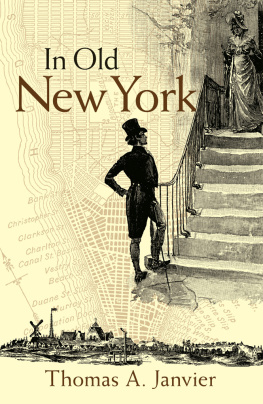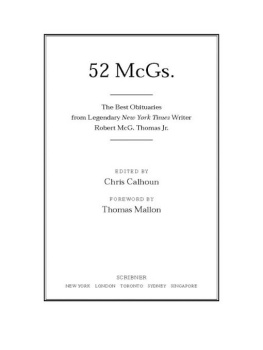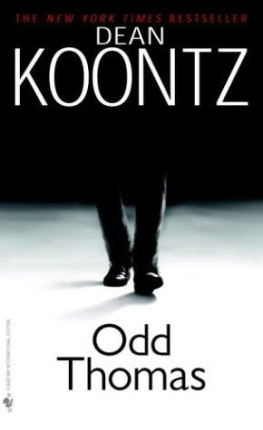TO
C. A. J.
Bibliographical Note
This Dover edition, first published in 2015, is an unabridged republication of the work originally published by Harper & Brothers, Publishers, New York and London, in 1894.
Library of Congress Cataloging-in-Publication Data
Janvier, Thomas A. (Thomas Allibone), 1849-1913.
In old New York / Thomas A. Janvier.Dover edition.
pages cm
Originally published: New York : Harper & Brothers, Publishers, 1894.
Includes index.
eISBN-13: 978-0-486-80570-2
1. New York (NY.)HistoryColonial period, ca. 1600-1775. 2. New York (NY.)History1775-1865. 3. Historic sitesNew York (State)New York. I. Title.
F128.4.J35 2015
974.702dc23
2015002550
Manufactured in the United States by Courier Corporation
79126201 2015
www.doverpublications.com
In Old New York
_______
THE EVOLUTION OF NEW YORK
I
T HERE was no element of permanence in the settlement of New York. The traders sent here under Hendrick Christiansen, immediately upon Hudsons return to Holland in 1609, had no intention of remaining in America beyond the time that would pass while their ships crossed the sea and came again for the furs which meanwhile they were to secure. Even when Fort Manhattan was erectedthe stockade that was built about the year 1614 just south of the present Bowling Greenthis structure was intended only for the temporary shelter of the factors of the United New Netherland Company while engaged with the Indians in transient trade; for the life of this trading organization specifically was limited by its charter to four voyages, all to be made within the three years beginning January 1, 1615. Fort Manhattan, therefore, simply was a trading-post. If the Companys charter could be renewed, the post would be continued while it was profitable; upon the expiration of the charter, or when the post ceased to be profitable, it would be abandoned. That the temporary settlement thus made might develop, later, into a permanent town was a matter wholly aside from the interests in view. Leavenworth, Denver, a dozen of our Western cities, have been founded in precisely the same fashion within our own day.
Not until the year 1621, when the Dutch West India Company came into existence, were considerate measures taken for assuring a substantial colonial life to the Dutch settlement in America. The earlier trading association, the United New Netherland Company, expired by limitation on the last day of the year 1617; but its privileges were revived and maintained by annual grant for at least two years; probably for three. Then the larger organization was formed, with chartered rights (so far as the power to grant these lay with the States General of Holland) to the exclusive trade of all the coasts of both Americas.
Unlike the English trading companieswhose administration of their colonial establishments flowed from a central sourcethe Dutch West India Company was in the nature of a commercial federation. Branches of the Company were established in the several cities of Holland; which branches, while subject to the authority (whereof they themselves were part) of the organization as a whole, enjoyed distinct rights and privileges: having assigned to them, severally, specific territories, over which they exercised the right of government, and with which they possessed the exclusive right to trade.
In accordance with this scheme of arrangement, the trading-post on the island of Manhattan, with its dependent territorybroadly claimed as extending along the coast from the Virginia Plantations northward to New England, and inland indefinitelybecame the portion of the Amsterdam branch; wherefore the name of New Amsterdam was given to the post, even as the territory already had received the name of New Netherland.
As a commercial undertaking, the Dutch West India Company was admirably organized. Its projectors sought to establish it on so substantial a foundation that its expansion would not be subject to sudden checks, but would proceed equably and steadily from the start. To meet these requirements, mere trading-posts in foreign countries were not sufficient. Such temporary establishments were liable to be effaced in a moment, either by resident savages or by visiting savages afloat out of Europefor in that cheerful period of the worlds history all was game that could be captured at large upon or on the borders of the ocean sea. For the security of the Company, therefore, it was necessary that the New Netherland should be held not by the loose tenure of a small fort lightly garrisoned, but by the strong tenure of a colonial establishment firmly rooted in the soil With this accomplished, the attacks of savages of any sort were not especially to be dreaded. Colonists might be killed in very considerable numbers and still (the available supply of colonists being ample) no great harm would be done to the Companys interests, for the colony would survive. Therefore it was that with the change in ownership and in name came also a change in the nature of the Dutch hold upon this island. Fort Manhattan had been an isolated settlement established solely for purposes of trade; New Amsterdam was the nucleus of a colonial establishment, and was the seat of a colonial government which nominally controlled a region as large as all the European possessions of Holland and the German states combined.
It would be absurd, however, to take very seriously this government that was established in the year 1623. The portion of the American continent over which Director Minuit exercised absolutely undisputed authority was not quite the whole of the territory (now enclosed by the lower loop of the elevated railway) which lies south of the present Battery Place. Within that microscopic principality he ruled; outside of it he only reigned. That he was engaged in the rather magnificent work of founding what was to be the chief city of the Continent was far too monstrous a thought to blast its way to his imaginative faculty through the thickness of his substantial skull.
Yet Fort Amsterdam, begun about the year 1626its northern wall about on the line of the existing row of houses facing the Bowling Greenreally was the beginning of the present city. The engineer who planned it, Kryn Frederick, had in mind the creation of works sufficiently large to shelter in time of danger all the inhabitants of a considerable town; and, when the Fort was finished, the fact that such a stronghold existed was one of the inducements extended by the West India Company to secure its needed colonists: for these, being most immediately and personally interested in the matter, could not be expected to contemplate the possibility of their own massacre by savages of the land or sea in the same large and statesmanlike manner that such accidents of colonial administration were regarded by the Companys directors. The building of the Fort, therefore, was the first step towards anchoring the colony firmly to the soil. By the time that the Fort was finished the population of this island amounted to about two hundred souls; and the island itself, for a consideration of $24, had been bought by Director Minuit for the Company : and so formally had passed to Dutch from Indian hands.










